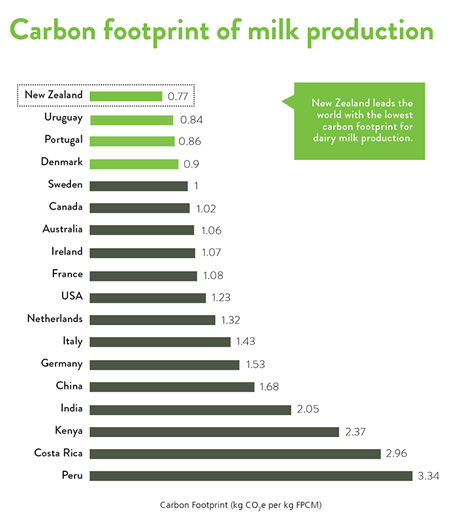



Research says New Zealand dairy is world’s most emissions efficient
New research shows New Zealand dairy farmers have the world’s lowest carbon footprint – at half the emissions of other international producers.AgResearch analysis released today confirms New Zealand retains its outstanding position in low-emission dairy milk production, with an on-farm carbon footprint 48 percent less than the average of 18 countries studied.
 Commissioned by DairyNZ, the study was independently produced by AgResearch and peer-reviewed by an international specialist in Ireland.
Commissioned by DairyNZ, the study was independently produced by AgResearch and peer-reviewed by an international specialist in Ireland.
The research analysed 55 percent of global milk production, including major milk producing countries.
New Zealand is the most efficient producer at 0.77 kg CO2e per kg FPCM (fat and protein corrected milk) – which is 48 percent less than the average of the countries studied. The average is 1.47 kg CO2e per kg FPCM.
DairyNZ chief executive Dr Tim Mackle said the research plays a key part in understanding how New Zealand dairy farms stack up and informs how our farmers can be even more efficient.
“New Zealand’s dairy sector is committed to remaining the most efficient producer of low emissions milk in the world. Our focus as a sector is sustaining our success as consumers and communities increasingly seek sustainably produced food,” said Dr Mackle.
Dr Mackle said there is a huge amount of work underway to support farmers to reduce emissions.
“New Zealand dairy farmers’ hard work and investment over decades has contributed to this world-leading status. Our grass-based, outdoor grazing system is unique globally and is critical to our success.
“Because we are already so efficient, there is no silver bullet to even greater efficiency. Significant investment in research and development is needed to find solutions.
“Our sector is committed and has research underway. We need Government support as we adopt new knowledge, practices and technology.”
At 0.77 kg CO2e per kg FPCM, New Zealand was followed by Uruguay at 0.84, Portugal at 0.86, Denmark at 0.9 and Sweden at 1. Peru clocks in as the highest emissions producer among the countries studied, at 3.34 kg CO2e per kg FPCM. Peru is followed by Costa Rica at 2.96 and Kenya at 2.37.
The carbon footprint is measured in total greenhouse (GHG) emissions per kg of product.
The research compares carbon dioxide equivalent (CO2e) emissions per kilogram of milk (fat and protein corrected milk – the nutritional content recognised in the study as CO2e per kg FPCM). This is an internationally recognised method.
The countries selected had published research that enabled a like-for-like comparison.
AgResearch scientists Andre Mazzetto and Stewart Ledgard led the research, following methodology in line with International Organisation for Standardisation (ISO) standards.
Dr Mazzetto said it is always challenging to compare carbon footprinting studies, due to different methods in each scientific paper.
“Here, we reviewed international studies and recalculated their footprints in a systematic way, using methods accepted internationally to provide a fair and robust comparison between different countries,” said Dr Mazzetto.
“Bearing in mind, countries may have different emission profiles and different ways of calculating their footprints for milk production, we believe we have reached the best possible comparison from the data available.
“New Zealand is known internationally for its low carbon footprint of dairy product, which is supported by this research. There is still potential to improve and achieve lower emissions as other countries also advance their dairy sectors.”
Waikato dairy farmer and Climate Change Ambassador George Moss said pasture-based farming and genetic improvement are important components.
“Grass-based farms and sophisticated animal breeding are key components to our low carbon footprint but there is more we need to do as we play our part in addressing climate change,” said Mr Moss.
“We are world-leading at emissions efficient milk production, but we must continue to adapt and adopt new technology and knowledge. Our global competitors are never far behind, plus we know it is the right thing to do for our environment, our consumers and humanity as a whole.”



